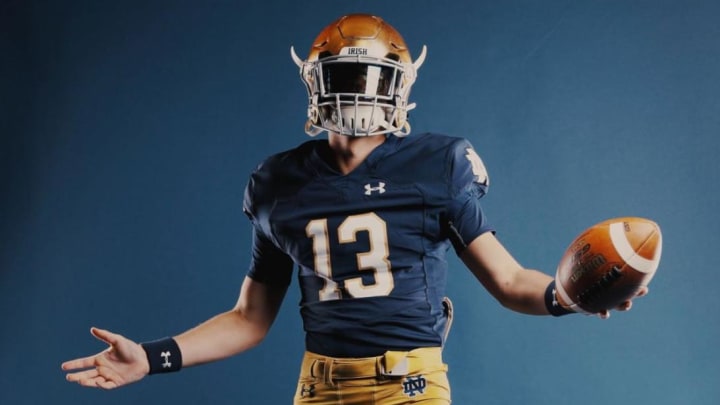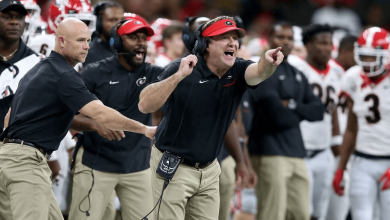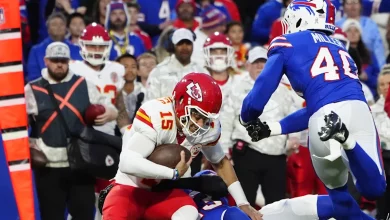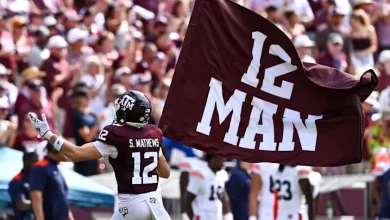CJ Carr was the most effective QB, leading a scoring drive with two deep completions, good decision-making, and composure under pressure. Only QB to score. Jadarian Price ran well.

The recent Notre Dame spring scrimmage provided valuable insight into the depth and talent of the quarterback room, as well as a chance for young players to make their mark. With three quarterbacks—Steve Angeli, Kenny Minchey, and true freshman CJ Carr—each getting reps, the scrimmage revealed strengths, weaknesses, and a potential early glimpse at who might be ready to take meaningful snaps in 2025. Among them, CJ Carr stood out as the most effective and poised, showing a level of control and playmaking that separated him from his more experienced counterparts.
Let’s break down each quarterback’s performance, starting with the opening drives and zooming in on situational awareness, accuracy, decision-making, and overall offensive impact.
Steve Angeli: Conservative, Inconsistent, and Limited Mobility
Steve Angeli, expected to be one of the leading contenders in the quarterback battle, opened the scrimmage with a drive that left much to be desired. On the surface, his performance was conservative, with a noticeable reliance on check-down passes and short throws. His opening drive featured one solid throw downfield, but it was quickly overshadowed by two poorly placed deep attempts that failed to connect. This lack of consistency on longer routes stunted the offense’s momentum early.
A notable limitation was Angeli’s complete absence of mobility during the drive. Whether by design or personal decision-making, he didn’t take any chances on the ground, even when the pocket collapsed or plays broke down. While he remained poised under pressure, his unwillingness or inability to escape or extend plays was a glaring weakness.
Despite reaching the red zone—largely thanks to solid work from running back Jadarian Price—the offense failed to convert. A missed field goal ended the drive, and Angeli left the field having moved the ball but failed to generate any points.
Key Takeaways:
- Safe but overly conservative.
- Lacked effectiveness in the vertical passing game.
- No mobility or improvisational ability shown.
- Failed red zone execution.
Kenny Minchey: Energetic Start, Stalled Execution
Kenny Minchey entered the scrimmage with energy and tempo. His first drive was a blend of quarterback runs and quick passes, suggesting a different offensive rhythm from Angeli’s series. Notre Dame tested a 3QB, 1RB package to open Minchey’s series—likely a coaching experiment—but Minchey’s overall command of the offense was evident. He looked composed and communicated well at the line.
However, despite early promise, the drive fell apart on a crucial fourth-and-six play. Instead of settling for a short punt or long field goal, the offense stayed aggressive. Minchey dropped back, but the protection broke down, and he was sacked—stalling the drive before it could reach scoring range. While it’s worth noting that Minchey’s effort to push the ball downfield wasn’t the issue, the offense just lacked rhythm and failed to finish.
One major drawback of Minchey’s scrimmage was the limited evaluation window. Aninns Williams, a potential receiving threat, was on the field for very few snaps during Minchey’s drive, limiting the variety of targets and play-calling Notre Dame could evaluate in this offensive set. Without more snaps or data, it’s difficult to draw firm conclusions about his performance beyond the early situational control and late-drive stall.
Key Takeaways:
- Showed poise and good command of the offense.
- Opened with balanced QB/RB design but couldn’t sustain momentum.
- Sack on fourth down killed the drive.
- Incomplete evaluation due to limited playmakers on field.
CJ Carr: Poised, Productive, and Ready Beyond His Years
Then came CJ Carr—the highly touted freshman who has yet to take a collegiate snap in live action but played like he belonged. Starting his drive deep in his own territory at the five-yard line, Carr immediately faced pressure and challenging field position. But what followed was the most complete and productive drive of the day by any quarterback.
His first play featured a solid run by running back Jadarian Price, helping ease some pressure. Then, Carr launched a perfect deep ball that resulted in a big gain, energizing both the sideline and crowd. This wasn’t just a flash play—it was a well-thrown, well-timed pass that showed Carr’s elite ball placement and understanding of route timing.
Carr continued the drive with short passes, showing that he could operate underneath as well, keeping the chains moving. Another Price run helped them convert a first down, and then Carr unleashed a second impressive deep throw—this one for 24 yards. It was another display of touch, anticipation, and a clear understanding of where to place the ball.
When faced with pressure later in the drive, Carr didn’t panic. He showed pocket presence and attempted to escape, but due to his “green-shirted” non-contact status, the play was blown dead. In a real-game situation, Carr may have made a positive play with his legs. Still, his awareness and effort to keep the play alive showed veteran instincts.
One holding penalty on a tight end threatened to stall the drive, but Carr quickly got the offense back in rhythm with a smart short pass. Ultimately, the offense faced a fourth-and-ten in the red zone and settled for a field goal—the only scoring drive of the entire scrimmage. While it wasn’t a touchdown, Carr successfully managed a long field, demonstrated control under pressure, and ended with points. That’s something neither Angeli nor Minchey accomplished.
Key Takeaways:
- Operated the offense with poise and precision.
- Two excellent deep throws—showcased arm talent and timing.
- Managed adversity well (penalties, pressure, bad field position).
- Only quarterback to lead a scoring drive.
Running Back Spotlight: Jadarian Price Makes His Case
It’s worth noting the role that Jadarian Price played during CJ Carr’s drive. The running back was a consistent positive throughout, contributing with chunk runs and timely pickups. His presence allowed Carr to use play-action effectively and also provided a safety valve when under duress. Price’s balance and burst gave the offense a rhythm it lacked earlier in the scrimmage, and if Notre Dame leans into the run game in 2025, Price looks like he could be a featured piece.
Comparative Analysis: Who Looks Game-Ready?
When comparing the three quarterbacks, the differences in their styles and effectiveness were obvious:
- Steve Angeli looked like a game manager, cautious and deliberate, but lacked the arm strength or aggressiveness to stretch the field or finish drives.
- Kenny Minchey brought tempo and a sense of confidence, but couldn’t translate that into sustained offense.
- CJ Carr, despite being the youngest and least experienced, looked the most polished, the most accurate, and the most capable of leading the offense down the field against a live defense.
Carr’s performance raised legitimate questions about whether he could push for meaningful reps sooner than expected. He didn’t look like a freshman. He looked like a quarterback ready for prime time.
CJ Carr’s first major on-field appearance at Notre Dame showed everything you’d hope to see in a future starter: confidence, control, touch, and composure. While it’s only a scrimmage, and live game speed is another beast entirely, Carr has clearly put himself in position to accelerate his path up the depth chart. He wasn’t just the most effective quarterback on the field—he was the only one to lead a scoring drive, and he did it from the shadow of his own end zone.
With continued development and more opportunities, it’s not out of the question that Carr becomes a serious factor in the quarterback competition sooner rather than later. For now, though, Notre Dame fans can take comfort in knowing that the future of the quarterback room looks incredibly bright.









